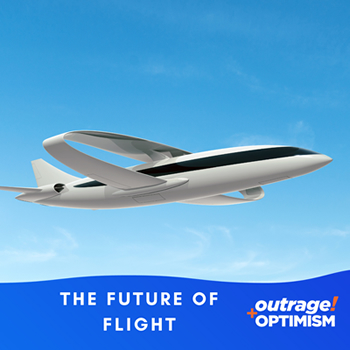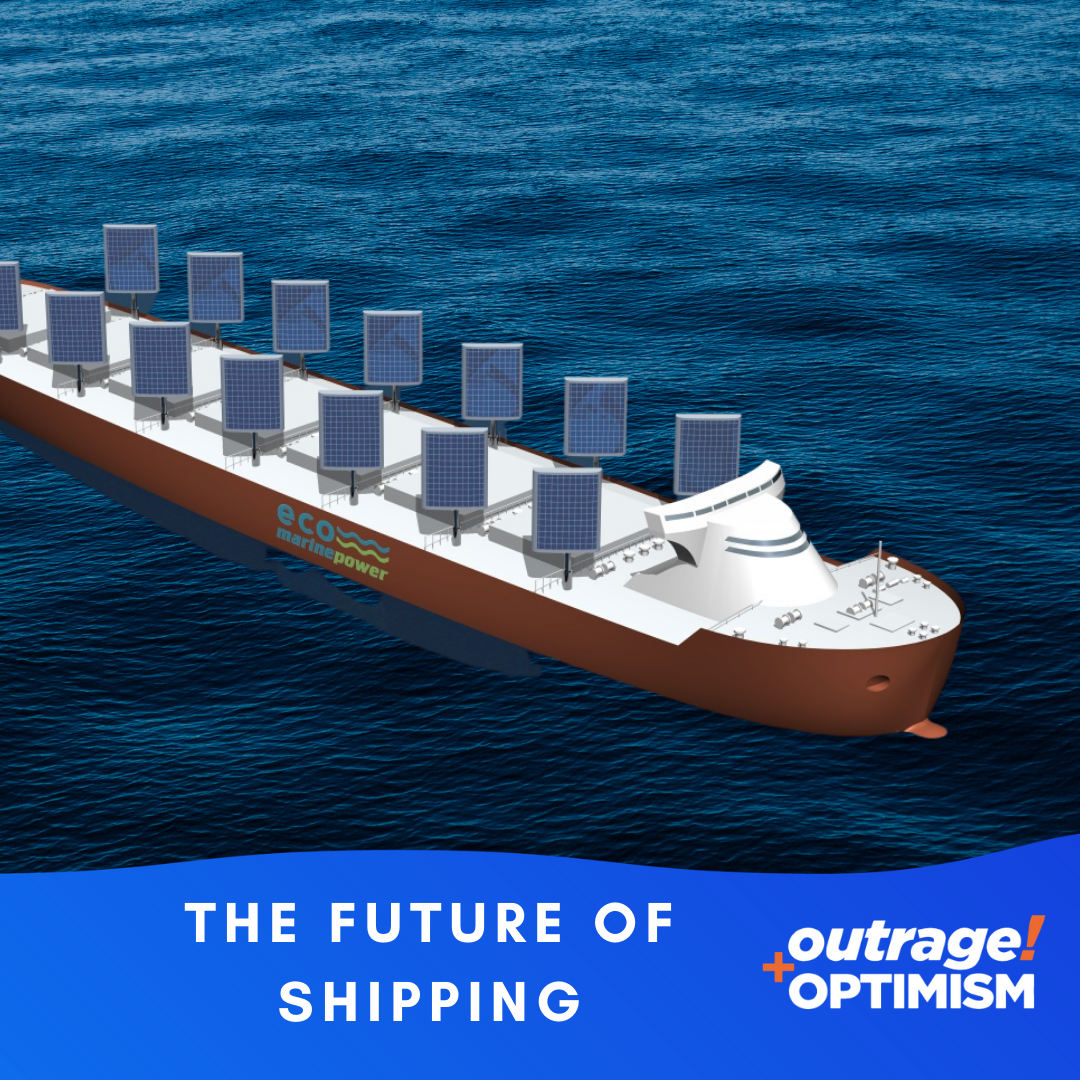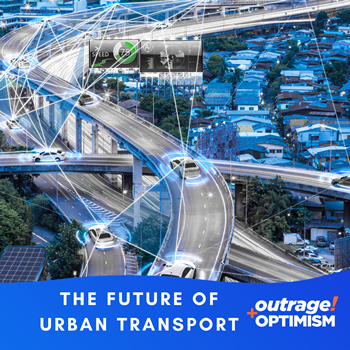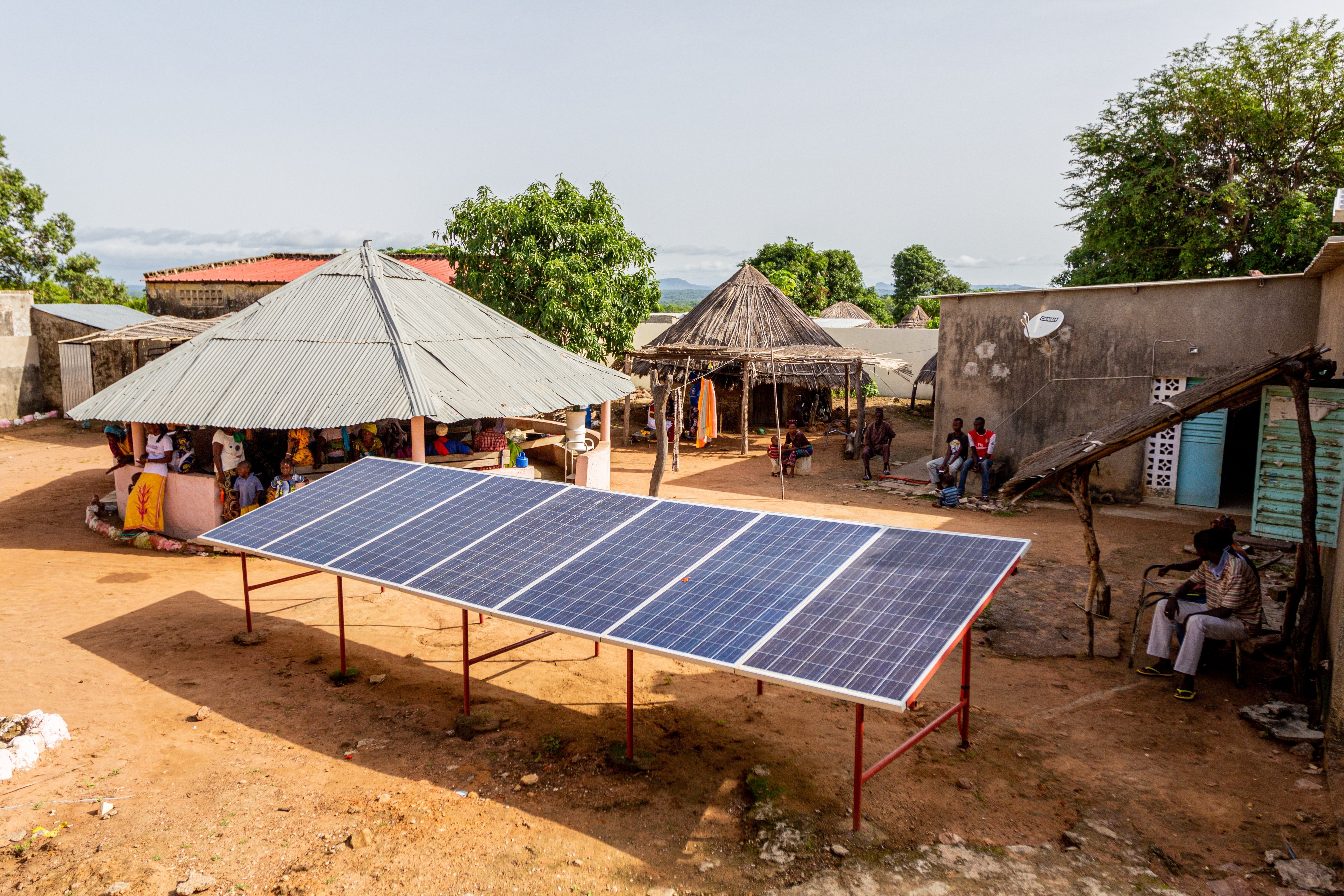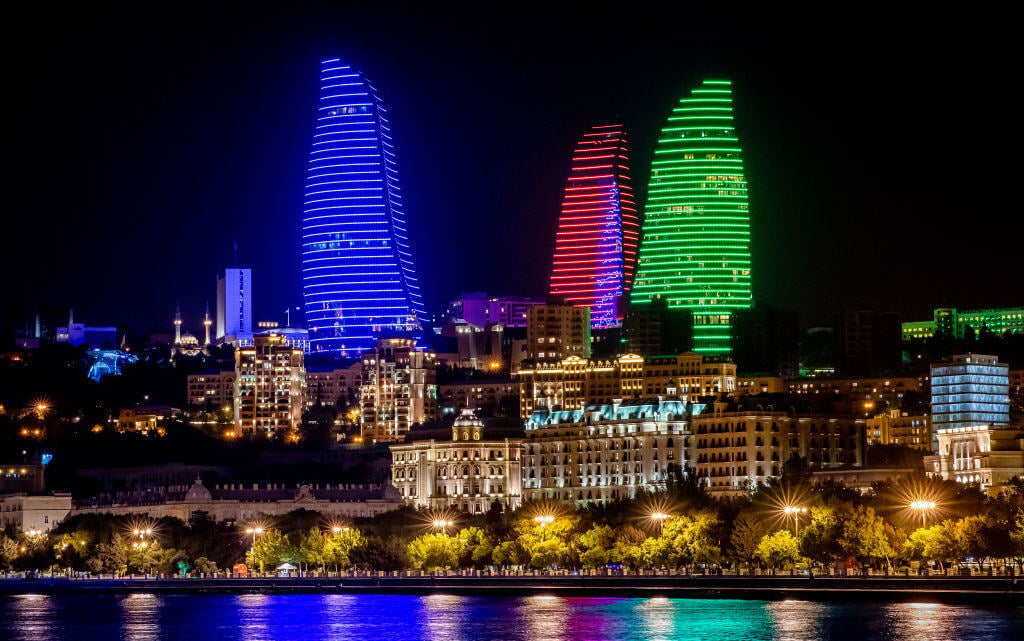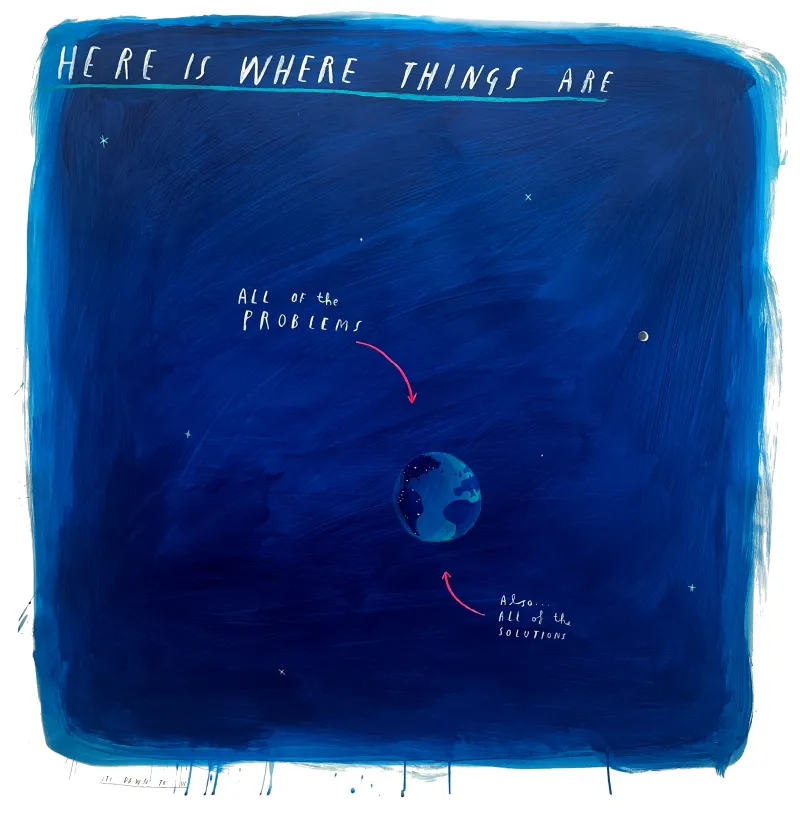80: The Future of Fuels
There’s no denying that for over a century, fossil fuels have played a key role in humanity’s progress. But at a cost.
About this episode
This is our second episode of an Outrage + Optimism investigative series on The Future of Transport. There’s no denying that for over a century, fossil fuels have played a key role in humanity’s progress. But at a cost. They account for two-thirds of global greenhouse-gas emissions, and the pollution from burning them kills more than 4 million people a year.
So in a year where cars sat unused, and oil prices crashed…what is the future of fuels? We know that in order to meet the Paris Agreement, we need to reduce CO2 emissions by 50% by 2030. Because even though COVID-19 is expected to reduce energy-related CO2 emissions by 7% this year, we need massive changes in how we move people and things.
So will we see the end of the internal combustion engine? How will the world go electric? Can hydrogen scale to meet our energy demands? Our hosts Tom Rivett-Carnac, Christiana Figueres and Paul Dickinson pull out the roadmap to a zero-emission future, hit the road looking for answers to a decarbonized transport sector with experts who are in the driver’s seat.
Read Tom’s blog to find out more from behind the scenes.
Watch David Lammy’s TED Talk before listening next week!
—
This series is sponsored by NESTE
Full Transcript
Transcript generated by AI. While we aim for accuracy, errors may still occur. Please refer to the episode’s audio for the definitive version
Tom Rivett-Carnac: [00:00:12] Hello and welcome to Outrage + Optimism. I'm Tom Rivett-Carnac.
Christiana Figueres: I'm Christiana Figueres.
Paul Dickinson: And I'm Paul Dickinson.
Tom Rivett-Carnac: This week, in a break from our normal format, we bring you the second in a special series of episodes looking at the future of sustainable transport. In a year when across the globe, cities fell silent, cars stayed stationary and oil prices crashed. We'll be looking at how emerging energy sources will shape the kind of vehicles we’ll drive in the years to come. There's no denying that for over a century, fossil fuels have played a key role in humanity's progress, but at a cost. They account for more than two thirds of greenhouse gas emissions and the pollution from burning them kills more than four million people a year. So in keeping with this podcast mission to balance both outrage and optimism, we'll be bringing you plenty of both.
Robert Llewellyn: [00:01:12] We'd all been born into a world where we sat in traffic jams with thousands of engines going brum, brum, brum, brum, brum, pumping out toxic carcinogenic gas, you know, and it was like, that's normal.
Monica Araya: [00:01:25] There is so much outrage out there when you really look at what pollution does to people in particular. I think the symbol of that outrage, at least in my case, is that tailpipe.
Alejandro Agag: [00:01:37] And I thought at the time, Formula One has got a problem, and I thought at the time we should create a green version of the sport, we should we should move in that direction.
Ramez Naam: [00:01:47] What's clear is the internal combustion engine for ground transport is dead, dead, dead, dead, dead, dead.
Tom Rivett-Carnac: [00:01:59] Now, even though the coronavirus pandemic is expected to result in a record seven percent decline in energy related greenhouse gas emissions this year, the International Energy Agency has warned against complacency because the road to a decarbonised transport sector is indeed long and winding. And without the ambition, commitment and stubborn optimism of people like the ones you're about to hear from, global emissions could still continue to rise to a point where there's no going back. That's on this episode of Outrage + Optimism. So one of the interesting things about the last five years since Paris has been the driving down of cost of renewable energy, and I think all of us have kind of witnessed that and we've been amazed at the fact that really today it is cheaper to generate solar and wind than really any other form of electricity. And I think most people listening to this podcast are probably familiar with that fact. But probably what people are less familiar with and what I myself was certainly less familiar with is the fact that transport is also transforming at an equally rapid pace to the point where decarbonised transport systems are going to become the norm within just a few years. Where are you guys on this issue? I've been tracking this as closely as you have the decarbonisation of power.
Christiana Figueres: [00:04:29] I am actually so excited about this. I can't tell you I'm very excited because, well, I think most of you know that I have been lobbying for the museum to the internal combustion engine to be built in Britain. And I would like to volunteer myself to be there at the opening of that museum. Honestly, right, if you think about the fact that we have had this internal combustion engine for, let's call it 100 hundred years and very little improvement of technology since then, how completely as my daughters would say five minutes ago, the fact that we're still using these vehicles with that completely outmoded, outdated, antiquated technology. And it's about time. It's about time to have a revolution in the technology that powers our transport.
Tom Rivett-Carnac: [00:05:23] I mean, it is important, isn't it, to sort of sit back and realise the pace of change, because living through these days, it can be difficult to realise just how quickly things are transforming. I mean, I remember even back in 2015, the idea of mass adoption of electric vehicles seemed, you know, decades away potentially, and hydrogen the same. And those things have really just been accelerated so much in the last few years. I mean, just a few data points. Tesla is now the most valuable car company in the world where you would have thought that a new entrant to the car market could become the most valuable car company in such a short space of time. At the same time, we see in the last few weeks Exxon Mobil ejected from the Dow Jones index, having been a member since the 1920s, because they've now been surpassed by so many other different entities that are focusing on the future. It's really and hydrogen. I mean, hydrogen is really capturing my attention at the moment, the degree to which both shipping and heavy trucking are going to be transformed remarkably to this this way of powering vehicles that releases water vapor from the tailpipe. It's really amazing how quickly things are changing. It's a huge source of optimism and hope for me.
Christiana Figueres: [00:06:31] It is just so exciting how the barriers, the mental barriers that we had given ourselves are just giving way to technological innovation and investment.
Load MorePaul Dickinson: [00:06:42] And it's the power of these commitments, these announcements about, you know, the phasing out of internal combustion engines. It's a kind of future truth. It pulls the future into the present and changes the way we manufacture and produce things now. And we get there, you know, with a focus on a target, a clear head and logic.
Tom Rivett-Carnac: [00:07:03] Now, what's amazing about all of this, of course, is the economics. And we've seen this is when things really change, right. When the economics and public perception and public policy all align to move in the same direction, the economics is moving in the direction we want it to. National commitments are also really accelerating. We've seen accelerated commitments on the phasing out of petrol and diesel cars from France, Germany, Norway. The UK recently came out and said 2030 big commitments from China, Japan and South Korea. And of course, also who could forget the fact that now the US is back in the game? Nobody is going to build another coal fired plant in America. No one's going to build another oil fired plant in America. They're going to move to renewable energy, number one. Number two, we're going to make sure that we are able to take the federal fleet and turn it into a fleet of electric vehicles, making sure that we can do that. We're going to put 500,000 charging stations in all of the highways that we're going to be building in the future.
Tom Rivett-Carnac: [00:08:00] To me, that's the signal they're coming from. The president elect of the United States will set the tone and we've seen this before when a national leader of that level of authority comes out and sends such a clear message around where they want to go, smart companies will invest and they'll innovate in response to that demand. And I think I would say already, even before he's taken office, that will have an impact on the strategy of the companies that can shape the future. So it's just such a fascinating issue. This I mean, how transport is going to be transformed will be fundamental to the whole future that we've been trying to create and that we keep talking about as within our grasp in this podcast. This is going to be an amazing episode and who better to lead you through it than Paul Dickinson? Here's Paul. He's going to take you on this journey and we'll see you back here at the end.
Christiana Figueres: [00:08:48] Sorry, it’s the Paul Dickinson.
Paul Dickinson: [00:08:48] Thanks, I do appreciate it. No, it's fine, so if you got it wrong. But thank you, Christiana, for the correction. I mean, just for the listeners. We start our journey in the US in particular in one state which for decades has been ahead of the federal government in terms of ambitious climate policy. And it's the birthplace of the EV or electric vehicle technology, and which this year witnessed first hand the utterly devastating consequences that climate change can bring to bear. Dozens of wildfires are burning up and down the West Coast. I'm sure you've seen some of the pictures. It's just harrowing. At least twenty five ravaging parts of California, north and south. Extreme heat, strong winds continue to fuel them. At least two point two million acres. So many homes have burned across the state. Hundreds of thousands of people were displaced and four million acres of land was lost when wildfires burned through California earlier this year. And whereas President Trump famously dismissed the connection to climate change.
Donald Trump: [00:09:56] It'll start getting cooler. I was just you just watch.
Paul Dickinson: [00:10:02] Scientists and experts were in no doubt about the real cause.
Mary Nichols: [00:10:06] The fires are made worse as a result of the damage that's been caused by global warming early on, the droughts that led to the bark beetles that killed so many trees that are still dying or dead in the forests and therefore became more vulnerable to fire and then later to the hot temperatures, which in turn bring in the winds that move the fires further and faster and make them so much more devastating.
Paul Dickinson: [00:10:34] That's clean air crusader and Trump nemesis Mary Nichols. She's chair of the California Air Resources Board. And in the aftermath of the fires, she worked with California Governor Gavin Newsom to order the ban on the sale of all non-zero emission passenger vehicles in California after 2035.
Mary Nichols: [00:10:54] He was horrified this this past several months have been the worst ever in California's history. He was feeling, I think, very strongly that he had to do more. He had to do something that was reactive. And so he's done two important things. One is the is the mandate for zero emission vehicles and the other which came a couple of weeks later, which was a mandate to improve our forest and land management, to make them more capable of absorbing and holding carbon. So this is it's definitely driven by the recognition of how horrible the fires are. He knows perfectly well that we're not going to replace all of our internal combustion engines quickly enough to make any immediate difference in the fire situation. But he also knows that if we don't start now, we won't get there. And we have already seen a couple of other states that have stepped up and said they're going to follow California in this regard. So it's very much seen as being a part of our climate program.
Paul Dickinson: [00:12:08] We spoke to marry when the results of the presidential election had not yet been confirmed. But we asked what difference the Joe Biden administration would really make.
Mary Nichols: [00:12:17] I believe that Joe Biden will direct his administration to take actions that can be taken under existing legal authority, that he will work with the Congress to try to get funding and support and legislation where he can to drive in the direction of using federal funds for an economic stimulus package, which will include some substantial incentives for clean energy and clean transportation. There's a lot of consensus from regions around the country, cities and states, saying they want to participate in the transformation of our of our system of transportation. They want to be part of a of a national program. And they're willing to do their part in terms of investing local funds and putting their land use authorities and other authorities behind the creation of a network of charging stations for electric vehicles so that this transformation, which I think most people, including CEOs of oil companies, believe is underway. So the fundamental question of whether we will be moving beyond petroleum, I think, has been settled.
Paul Dickinson: [00:13:43] And Mary's response to potentially being Joe Biden's pick to head up the US environmental protection agency?.
Mary Nichols: [00:13:48] We don't have time you know to wait around and be modest, so I'm planning I have made it clear when people have put my name forward to say I'm willing to serve in any way I can. The situation is desperate.
Paul Dickinson: [00:14:06] The situation is desperate. Hmm. So watch this space. But although Mary says we can and should be imagining a world beyond petroleum, fossil fuels still account for 80 percent of the world's energy and subsidies remain a significant barrier to global decarbonisation. Now, a study by the International Monetary Fund IMF showed that without those subsidies, you could have reduced global carbon emissions by nearly 30 percent today. A controversial topic worthy of its own deep dig. And we'll be doing just that and a future program down the line. But just to say, Joe Biden has pledged to work towards a world wide ban on fossil fuel subsidies. But can we end the oil addiction quickly enough to affect meaningful change?
Ramez Naam: [00:14:52] Yes, absolutely we can. It's a mistake to look at what we scaled so far because the leading variable is actually cost.
Paul Dickinson: [00:15:00] That's energy analyst Ramez Naam.
Ramez Naam: [00:15:03] The main thing we've accomplished with renewable energy and electric mobility is we've stunningly lowered their costs from when Germany started the energiewende to today. The cost of electricity from solar power has dropped by a factor of 30. The cost of shifting from wind power is up by a factor of 10, and that is what is disruptive to fossil fuels. I don't think the German people or politicians appreciated that at the time they thought that they were deploying clean energy to clean up their own emissions, which is a noble goal. But the major effect was that by scaling the technologies, solar and wind and Norway doing similar things with electric vehicles, for instance, it made the technologies get cheaper.
Paul Dickinson: [00:15:45] But of course, building the energy storage facilities is still a key factor. Can it be done?
Ramez Naam: [00:15:52] It can mean we have many options for how to decarbonise the grid. And in fact, storage is a solution. But the underlying issue is how do we balance intermittent and seasonal resources? And it turns out there's actually three or four different ways that you can you can go. Number one is we should build bigger grids. Every model academics do this all the time of how to get the highest usage of solar and wind at the lowest cost. And the low cost system is built continent sized grids. So then in Europe where you are, you can bring in solar from Spain, Italy, Turkey, even wind from the North Sea, the Nordics, the UK, and integrate them together and integrate over seasons. And then two very, very exciting wind power, both at sea but also on land. What we're doing to make the turbines bigger, they just operate more steadily, they're more reliable and they need less storage. And then three, finally, you have to do something on storage. And that's the one of the biggest challenges now. Multi hour storage. We're on a path to having that energy licked for four hours and even eight hours.
Paul Dickinson: [00:17:01] But while this is all very well and good for the developed world, what about the approximately 800 million people still living without electricity? Can renewables be scaled to eventually meet their energy demands?
Ramez Naam: [00:17:15] The most important thing that developed nations can do is to make clean energy options, clean electricity, clean mobility, clean industry, clean manufacturing, the cheapest and best options so that when people and whether it's China, India, Bangladesh, Congo go to choose their energy source, their heating source, their mobility source, they just automatically choose the one that's clean because it's the cheapest and the best.
Paul Dickinson: [00:17:43] And so where does that ultimately leave the fossil fuel companies in Europe?
Ramez Naam: [00:17:48] And you have Ørsted, formerly Dong Energy, Danish oil and natural gas. That's the lesson for energy companies Dong, now Ørsted, said it was an oil and natural gas company, but they had to look and say what's coming in the future? What technologies are working best, what is the world need? What is the world going to choose for policy reasons, for our own reasons, to have forests that survived, seas that we have fish in our world we want to live in, we're going to choose cleaner things. And so you have to ask yourself if you're the executive and the CEO of an oil and gas company as CEO of an energy company, because the first one is doomed. The second one, there's massive growth for the world's going to use much more energy in 2050 that it does today, but it's going to be clean energy.
Paul Dickinson: [00:18:39] And given Ramez is also a published science fiction writer, I asked him to gaze into the not so distant future, I think.
Ramez Naam: [00:18:47] Twenty years from now, we're going to be thinking of transport as a service, how do you access much more than we think about car ownership, but in the future, it's going to be much more like, you know, hailing a ride. You know, you step outside, you're going to use an app. A vehicle is going to pull up to pick you up. It's going to be autonomous. There’s gonna be nobody in it. It's going to be electric because that's the cheapest cost per kilometer or per mile. And it's going to be right sized for your needs on a short cross city trip. It's going to be a tiny little pod, one seat or two seater. The inside is going to be a giant service for entertainment if you want it to be, or you'll have your tablet or laptop or VR glasses or whatever in the future, and you're going to know disappear into your own world if you want to while you travel or if you're moving your family, you're going to use some of the somewhat larger vehicles going to take. You don't have the capacity to move. You are where you want to go. And I think that's what's going to what it's going to be. Look, none of this is happening as fast as we want. We need to use more policy to scale all of these solutions on electricity and on transport and on industry even faster. But it's happening a lot faster than people in industry, especially in the fossil fuel industry or the automotive industry, think it's going to happen. And what's clear is the internal combustion engine for ground transport is dead, dead, dead, dead, dead, dead.
Paul Dickinson: [00:20:18] Someone who would agree with Ramez that we can't take our foot off the accelerator on this is Monica Araya. I'm actually here to share good news.
Monica Araya: [00:20:27] For the first time in our lifetimes, a big detox of transportation is possible despite the many problems we have or perhaps because of them.
Paul Dickinson: [00:20:38] That's Monica giving a recent TED talk. She works with leaders in government, business, philanthropy and activism to help make that all important shift towards emissions free transportation. And she's also the transport lead for the Climate Champions team, gearing up for next year's COP 26.
Monica Araya: [00:20:58] There is so much outrage out there when you really look at what pollution does to people. And in particular, I think the symbol of that outrage, at least in my case, is the tailpipe. I think they really symbolize something that we are going to have to let go of. 2020 in particular, tragic as it has been, is also a year where we start that new journey. One of the key drivers has five letters and is called China. China entered electric mobility in a big way because of an industrial strategy, you know, was not mobility per se. They wanted to do something with that sector. Analysts have admitted that they never saw electric buses moving at the pace they are moving right now. They never expected the electrification of buses to go at the pace that we have seen in places like Shenzhen in China, where you have entire fleets of 17,000 electric buses running in one city. So there is that. Then, of course, there is policy in place that has explained a lot of the electrification in Europe. So for example, if you look at now what is going on now in 2020, with the big companies, think about Volkswagen, think about Daimler and others, many have strict limits. You know when you look at the fleet, they have to meet certain standards that American companies don’t have to meet and you see the impact of regulations and you see the impact also of activism and you see the impact of innovations. Hmm.
Paul Dickinson: [00:22:29] But how do we ensure this transition is inclusive and isn't going to lock more people out of personal mobility?
Monica Araya: [00:22:36] It’s very important to put inequality in the conversation right at the beginning. If you look at California, there are low income communities that are really hit by diesel truck pollution. So one of the things we're going to have to do in telling the story of electrification, in bringing others on board is to say this is not about my Tesla is bigger than your Tesla. That's not where we're going, my friends. It's about looking for the opportunities that can help us decrease emissions, that can help us increase our health and well-being and can help us deal with this horrific inequality problem we have that is unacceptable and is outrageous. So California set a precedent for the world this year by saying we are going to accelerate the transition to zero emission trucks. What is really important to say is that that that battle wouldn't have been won with without the frontline communities. Many of them are communities that are not only hurt by social problems, but also by problems associated with racism and a lot of other systemic issues. But my point is, if you look at buses, buses for me coming from Latin America, electric buses, yes, they are, of course, about our climate and health. But it's about dignity. They are clean, they are beautiful, they are silent. And if you want to talk about happiness, ask the drivers, the drivers of the buses or the drivers of a truck because they have to get out and they don't have the tailpipe when they have to do the deliveries. So I'm very aware that it can, that electrification can come across as for the wealthy, because probably because of Tesla and at the same time, I am aware that for certain segments that is the story. But let's try to see the ways in which we can tackle the inequality and the pollution problem through electrification, because I actually think there is a space for a big win there.
Paul Dickinson: [00:24:57] And now someone who is way out ahead on the technology, Craig Knight, CEO of Hyzon Motors, that's a startup supplying hydrogen fuel cell powered commercial vehicles, including heavy duty trucks, buses and coaches.
Craig Knight: [00:25:12] The fuel cell is essentially an engine replacement using this static electrochemical technology to convert hydrogen into electricity. So a fuel cell vehicle is a fuel cell electric vehicle.
Paul Dickinson: [00:25:24] Craig has been working in this space for 20 years and he laid out his vision for highs and motors with Tom and Cristiana.
Craig Knight: [00:25:31] Our mission is essentially to accelerate the energy transition from fossil fuels to hydrogen in mobility applications. If we think about those applications, frankly, 10 or 15 years ago, fuel cell technology wasn't ready for the challenge. However, in recent years, there have been a lot of technological advances, not only within our group, but also in the industry as a whole. For on road trucking, hydrogen really poses a very unique proposition in in transitioning off fossil fuels because of the ability of the fuel cell technology to provide performance, which matches diesel trucks firstly. And it doesn't bring compromise, the kind of compromises that you have if you go off fossil fuels onto a battery electric truck.
Christiana Figueres: [00:26:24] Now, ultimately, the purpose here Craig is to eliminate fossil fuels as being the fuels of heavy transport, whether land or maritime. However, 98 percent of the hydrogen produced today is still being produced from natural gas. So how optimistic are you that we will be able to move over to green hydrogen, produced from renewables, produced from waste in a way that will meet the time frame of the energy transition?
Craig Knight: [00:26:59] So most hydrogen in the world today comes from natural gas and is produced at the point where it's going to be consumed or very close to it and delivered by a pipeline. But it's not easy to find in a pure form. It always tends to combine with something. So there is a there is work to be done to isolate hydrogen and make it useful for mobility applications. And obviously the very green and attractive way to make hydrogen is electrolysis using renewable energy. Because then there is there's no carbon used in the there's no carbon generated in the process of generating the electricity. So because hydrogen is difficult and somewhat expensive to move over long distances, we're strong believers in the concept of local hydrogen production for local consumption. And this is then all about a local sustainable ecosystem, creating local jobs and having very strong energy independence and energy resilience at a local level.
Tom Rivett-Carnac: [00:28:02] Craig, I love that answer, though, so that's so great to hear about that sort of local network of ecosystems. I've just got one more question. I just love to hear you talk a little bit about the relative costs of getting a hydrogen truck on the road and operating it today compared to a diesel truck. And when you think we'll get to the point that it will be more cost efficient to run a hydrogen fleet than a diesel fleet.
Craig Knight: [00:28:23] So it's our goal in the next two to three years in as many jurisdictions as possible for homeowners motors to be able to supply vehicles operating on a zero emission, zero compromised basis for governments and corporations to transition from fossil fuels, to be able to do this with the total cost of ownership at parity with what they're accustomed to on their diesel fleets today. So what we need for that is a few things we need that the time and scale effect of the ongoing innovation and ramping up of production around the fuel cells and the supporting systems that go into a vehicle. The next extremely important factor is the cost of the hydrogen itself. And that's where some of those supporting developments around hydrogen production technologies and we believe local hydrogen generation systems. We believe that's where they dramatically underscored the cost structure opportunity so that customers, fleet operators can choose to move to a zero emission fleet with no penalty on the cost and with absolutely no compromise on how the fleet operates. That's our goal and where we're enabled somewhat by the lower cost maintenance associated with electrical vehicle systems in general compared to mechanical systems.
Craig Knight: [00:29:50] Also in terms of breakdowns and unplanned time off the road becomes virtually non-existent because the systems are a lot smarter. They communicate a lot and you can see what's happening within all the modules within the fuel cell vehicle remotely. So you can be proactively addressing anything that looks like it could be causing a concern. You might be having a little bit of overheating somewhere, or you might have some issue with the airflow air intake, something like that. You can see that with remote data.
Christiana Figueres: [00:30:18] So hold on, so if I have a fleet of a hundred or five hundred hydrogen powered vehicles in my company, then I would literally have in my maintenance shop, I would have a huge screen that tells me it gives me all the information of every single one of those vehicles.
Craig Knight: Yeah.
Christiana Figueres: Wow.
Craig Knight: [00:30:39] Like you can set up algorithms so that so that, you know, immediately when there's anything that doesn't quite look right and then you schedule this vehicle to come in and for example, say you've identified that there's a problem with the air intake because there's just not enough air coming into that stack and you're seeing it constrained. Or when the truck pulls in, one of the mechanics already has the the air blower module. The truck pulls in, you change the air module, you do a quick test and you send the truck back out. There is no set of hours or days off the road waiting for spare parts to come in to fix whatever was wrong after the funny noise reported by the driver, none of that happens.
Paul Dickinson: [00:31:20] Ok, so it's the kind of time and cost savings Craig was talking about that will help drive companies to make the transition to fleet electrification, and that's where people like Sarah Forni play a key role. She's the senior manager of clean vehicles at sustainability nonprofit Ceres.
Sarah Forni: [00:31:36] And through their corporate electric vehicle alliance, they're supporting companies looking to swap the pump for the plug. We represent various different industries across the US economy, including telecommunications, e-commerce, shipping, electric power, big box retailers, and together our members are really eager to drive change. So they're really looking to send a strong demand signal to the market and also advocate for policies that make the transition not only possible, but also profitable, since they are extremely eager to adopt EVs for various different reasons. And really, you know, there is a strong business case there already, but they want to make it even stronger. And that's why we developed CEVA to really accelerate the deployment of EVs through corporate fleets, but then also enable more consumers to purchase EVs at lower prices as well. You know, companies and consumers are increasingly seeing that there's a lot of benefits associated with EVs. You know, it's not just environmental benefits, EVs are also offering significant fuel and maintenance cost savings. In fact, just for a small compact vehicle, you can see upwards of a thousand dollars per year in savings just on fuel costs alone. So if you imagine a corporate fleet that's you know racking up a lot of mileage and spending a ton of money on petroleum over the years, they're going to see a significant amount of savings if they switch over to EVs in terms of their operational costs. And then on top of that, you know, there’s a lot of avoidance of risk in terms of improved fuel supply and price stability if you switch to EVs compared to internal combustion engine vehicles. It’s better for workforce recruitment in the current day and age. People wanna work at a company that has a great reputation for sustainability and working hard on climate with a great agenda and is setting aggressive goals. On top of that companies are also eager to set more ambitious sustainability goals in general. And they know that if they can switch over to EVs, they can help meet those goals even faster.
Paul Dickinson: [00:33:19] And it isn't just the startups looking to capitalize on ambitious corporate transport sustainability goals. Established vehicle manufacturers are also having to face a future without the internal combustion engine. Martin Daum, CEO of Daimler Trucks and Buses, and it's been with the company for over 30 years. But as he admitted to Tom and Christiana, he wasn't entirely convinced the trucking business was ready for such a change.
Martin Daum: [00:33:46] I never was against fighting climate change, the only issue is I could never imagine that in the truck world that might come to play. Why? Because zero emission tech is always more expensive than it usually does. Believe me, as someone who has really worked his entire life in this industry, there is a reason why we run on diesel these days. Why? Because it's the most efficient way to burn, to create energy, to propel them 40 tonnes forward or up a hill, which needs an incredible amount of energy. But why? Why did I change my behaviour? The number one point was always it's too expensive. No customer would ever buy it. And that is still too, by the way, today. And we could potentially elaborate a little bit about that later. But there came another one is I there was always a talk about the Paris climate accord. And I asked various people even out of the environmental movement and ask him always, what does Paris Accord mean? And nobody could explain it to me. And that is for a rational person, might be always enrages me and said, hey, guys, this is emotional. So we put the stick on Paris is good and trucks are bad and this is a world I don't like. So then I started to research what Paris really means.
Martin Daum: [00:35:03] And it means that if we want to stop the global climate change, we have to stop the increase of temperature to stop that increase of temperature. We are not allowed to emit CO2 by 2050. And that got me because first of all, I know if our planet becomes uninhabitable in areas where millions, hundreds of millions of people live, it's not a pleasant place anymore because every scene we see these days is migration. Migration is small against what might happen if we have vast areas of the world uninhabitable and we have to fight that. And for that, the Paris accord is absolutely right. And if we don't emit CO2 by 2050, we shouldn't sell trucks by 2040. And 2040 is just around the corner in our industry. So we better start today and don't waste another day. And that was about two years ago. And since then, we are pushing big time to get CO2 free by 2040.
Christiana Figueres: [00:36:11] Well, I am I'm so glad that I joined the conversation when you were saying Paris is right. That was exactly the moment for me to join the conversation. Thank you very much for that. Martin, just a quick last question. Can this transition be done with the current level of fossil fuel subsidies?
Martin Daum: [00:36:32] Subsidized fossil fuels is just a cheap, cheap source of energy. That's the entire problem. So in my opinion, we have to tax it more. We need we have, for example, in Europe at the moment, in part in Europe, NOX, nitrogen oxide based, that has to be my opinion, changed into a CO2 based with zero emission vehicles much less than CO2 emitting vehicles. We need the best thing would be higher prices on gas gasoline and diesel. I tell you, if you really want Paris happening, if every politician in the world to sign that Paris accord would tomorrow say every single January 1st, there's 10 cent more tax on diesel and gasoline from now to eternity. I tell you, by 2050, not a single person would drive a combustion engine car. We don't need any regulation, a free market economy would push that. But no politician is saying that because he fears that kick in flashback of his or her voters.
Paul Dickinson: [00:37:44] And just to note, it was only days before we spoke to Martin that Daimler announced a joint venture with Volvo trucks to develop and produce fuel cell systems for heavy duty vehicles.
Martin Daum: [00:37:54] The main argument by joining forces with Volvo was always to give to the infrastructure industry infrastructure, I mean here to infrastructure, a big sign that the two biggest players in North America and in Europe are joining forces and really are serious about it and putting serious money behind our words. It's not just an announcement. We together vowed and signed contractually that we spend another huge triple digit million amount in getting the fuel cell as fast as possible up and running. And I would say this signal to the market that we are truly serious and it's not just Daimler. It's not just one crazy CEO. This is serious and it's serious for the two biggest players in the global trucking belt.
Paul Dickinson: [00:38:54] Now, someone who has literally been in the driving seat of many an electric car, bus and truck is Robert Llewellyn. He launched Digital Channel, fully charged ten years ago and has been road testing and reviewing the very latest ever e-vehicles ever since. Hello and welcome to Fully Charged. This is a really exciting episode for me. I really wanted to heat the Model three because I didn't want to be a Tesla fanboy, but as soon as I sat in one, I went damn, it's really good. It's better than anyone else's car. Damn, damn, damn. I'm a Tesla fanboy. Anyway, let's get going. So what spiked Roberts interest way back long ago, in a world even before Tesla?
Robert Llewellyn: [00:39:40] I used to make a regular TV show called Scrapheap Challenge in the U.K. or Junkyard Wars in the United States. And it was through there, my contact with a lot of engineers and people working in the automotive industry that gave me probably an early signal that something was happening. There were a lot of developments in software, in battery technology, in electric drive trains that was going on very much under the radar. You know, it wasn't there was nothing sort of public going on. And I was hearing about this, particularly in the United States, particularly in California, where that stuff was developed. And I didn't understand it. And I didn't think it was important. I wasn't. I instantly converted, but it kind of stayed in me. And then you'd gradually hear things. And I heard about in the United States, the California Air Resources Board, the EPA, doing research on what happens when children breathe an immense amount of toxic fumes coming out of millions of internal combustion engines, all that stuff, which is now blatantly obvious. But at the time it was like, oh, really?
Robert Llewellyn: [00:40:46] I didn't know that was bad, you know, because we were used to it. We'd all been born into a world where we sat in traffic jams with thousands of engines going up, pumping out toxic carcinogenic gas, you know, and it was like, that's normal. But eventually I started to understand the battles and the realities of whether an electric vehicle was viable. Because when I first heard about it and the first common examples we saw, there was a car that was popular in London called the Gee Whiz, which had about 35 miles range at about 40 miles an hour flat out. And it was basically a cardboard box with wheels. And they weren't safe. It wasn't officially a car. You know and you think that's an electric car? I don't think that's going to catch on. It's just a very unique sort of niche thing. But then gradually, the technology, you could see it evolving. And this is pre Tesla and then you sort of hear about Tesla. And I went to an event in London where they unveiled the Tesla Roadster and someone introduced me to this man and they said, this is this is Elon Musk. And I went, oh, how did you do? And he said, How do you do? It's nice to meet you. That was the sum total of our conversation. I'd not heard of him. I didn't know who he was, you know. And then you go then it starts to all click together and you go, oh, my goodness, this is extraordinary. This is a big event. So that's really how it came about. And by that time, there were then some electric vehicles around, you know, that we could test like one or two.
Robert Llewellyn: [00:42:16] So Tesla got a Tesla Roadster for a weekend. They very generously lent me and a Nissan Leaf kind of early versions of the Nissan Leaf, the Renault Zoe, and really kind of grew from that point. But it was always not just about cars and that I picked that up pretty quickly and early on from engineers, not me working out, engineers going, that's a battery on wheels that you could run your house on. And just now, the other side of that screen behind me is a vehicle to grid unit. That is this is being run off my car at the moment. So, you know, that stuff can happen and that you then go, this isn't we're not talking about new cars. This is a different technology we've never had before. It's a computer and a battery on wheels that you can ride around in. But it's much more useful when you're not riding around in it, which the cars we've all been used to. They're just lumps of stuff in the way when we're not using them, which is about 90 percent of the time. So we've got a system that doesn't work. So what we're proposing is a system that is more useful, less damaging, better.
Paul Dickinson: [00:43:22] Ok, ok. But how can the phasing out of the internal combustion engine be managed so that those who can't just go out and buy new electric car won't be penalized?
Robert Llewellyn: [00:43:32] I mean, I think the carrot should be massive and the stick should be very small because I think I you know, the really bad example we have in this country, in the UK is diesel is diesel cars. If you've got any memory and you're of the generation that remembers being encouraged to buy diesel to be told, five years later you're driving the filthiest, most toxic vehicles of the human race it ever produced. That's a real problem. So you've got to balance that encouragement, I think. And you what you want to show is you've got this diesel car, nothing to do, you know, stupid. If don't forget that the government encouraged you to buy. Here's one over here. Have a go in it. It's electric and it's much better. But you choose yourself, you know, there's no longer an argument about which is the better technology. And that's what excites me, that I do these things like drive a car, really complicated machinery. I haven't burnt anything to do it. It's fantastic. First time that human beings have done this without heat. My house, without burning anything, I can cook food without burning anything, you know, really important changes.
Paul Dickinson: [00:44:39] And when that change comes to a major sporting event, which for years has been a monument to the roaring noise of the internal combustion engine, you know, there's no going back. We go green in Berlin. It pretty even starts up at the front down towards someone and immediately covers the inside, tries to send it to the outside. Just listen to that. Rest to the outside and gets the job done. Could that be the future sound of silent motor racing. Christiane, I caught up with the founder and chair of Formula E, Alejandro Agag.
Christiana Figueres: [00:45:15] Alejandro, muchos gracias. Thank you so much for joining us on Outrage + Optimism. I want to take you back in history just a little bit to your original, let's call it departure from Formula One. And you decided to do something completely different. Why?
Alejandro Agag: [00:45:38] Well, Christiana, always great talking to you. I would love that the question, the answer to this question would be purely for environmental reasons. But I have to say it wasn't. It’s not to say that I'm not worried about the environment. I've always been worried about the environment. When I was in the European Parliament, I was it was one of the topics I was focusing on. But when I was in Formula One, I was trying to convince a big corporation, a sponsor to come into the sport, and they were almost there. But then at one point, and this is already 12 or 14 years ago, that company said, listen, we're kind of going. I said, well, why? And they said, because we don't want to associate with combustion. We need to change our mindset. We need to go to clean sports. And I thought at the time, Formula One has got a problem. And I thought at the time we should create a green version of the sport. We should we should move in that direction. So the reason is mixed. Of course, I worry about the environment, but it wasn't purely let’s say altruistic.
Christiana Figueres: [00:46:41] Well, I would say our environmental care and commercial viability or profitability is a powerful combination.
Alejandro Agag: [00:46:49] I couldn't agree more. I think and I know you make this case very often, but I think if we really want to make big changes, not small changes, which are of course, a lot of them added are important, but if we want to make big, big changes, you need an economic case for it and you need to make it profitable. And I think that's the way to that to go. But for that, you're going to need a lot of technology, I think technology, the one that can marry those two and make sustainability also profitable.
Christiana Figueres: [00:47:17] So talk to us about the playground nature, the experimental nature, the gym, gymnasium nature of your races as being the exciting sporting event that we all love, but also the very important opportunity to improve technology.
Alejandro Agag: [00:47:38] Motorsport has always been not only now has always been a kind of a laboratory, a platform where you make the technology advances that then you can use on road cars. Even the rearview mirror was invented in a race. Formula E wants to be a platform and also Extreme E where car manufacturers can test the big advances on electric mobility and then use them on the road cars, making them better. What's better? Making them cheaper, making them go farther so the batteries is really the battlefront of electric car evolution and all those and also making charge a lot faster. We are looking at ultrafast charging, in Formula E. We're experimenting with that. So imagine you can charge your electric car in five minutes. That will change completely the perception of people about electric cars. Or you can have an electric car that can go for a thousand miles that will change. Those technologies are the one that can come from motorsport to the road cars.
Christiana Figueres: [00:48:37] And Alejandro, how quickly do you see the impact of the sporting event on the uptake of passenger EVs in in the public?
Alejandro Agag: [00:48:50] That's a key question. And we've done research about it. We've asked the people exiting our events, are you closer today than yesterday to buying an electric car? Ninety nine percent of the people said “yes, I’m closer”. By seeing these cars in a racing way, in a racing format, something that was before only reserved for big combustion cars, you take a big leap. You take a big step of changing the mindset of the people, because let's be honest, at the end, the car is a question of mindset.
Christiana Figueres: [00:49:18] Alejandro so there are many differences between Formula One and Formula E. But one very exciting difference is that because the electric race cars are not as loud by far as Formula One cars, you can race in cities in the middle of cities, which you cannot do with Formula One. Talk to us about that.
Alejandro Agag: [00:49:38] That's absolutely true. We were negotiating with London, with the city of London and the borough we wanted to race in in Battersea Park, said, listen, we have one condition. The noise is the big limitation for us. So we are going to open the park for you. The place where we're going to race at 4:00 in the morning. We want you to bring a car there. And if anybody wakes up, we're not going to give you the permission to race. So we took a car at four in the morning to race the car around the park at full speed like we had like, you know, of course, security. So nobody would come into the park or anything. And nobody in the neighborhood woke up and then they gave us permission to race in London. So that tells you how important the silence is to racing in cities and how the future would be much better in cities with electric cars in terms of the noise that you hear all the time, really.
Christiana Figueres: [00:50:27] And I'm glad I asked that. And talk to us now about Extreme E Alejandro. This is what your second big adventure in electrification, electrification of vehicles. That is another frontier that you are hoping to conquer.
Alejandro Agag: [00:50:46] Extreme E is all about going one step further on what we started doing with Formula E. We want to make electric cars to the most remote corners of the planet that are affected by climate change to show what's going on there. There is a fact: more people watch sports than environmental documentaries. And, you know, I was watching the fantastic Attenborough documentary that was on Netflix the other day, but sports beat that documentary hundredfold. So our idea is to use a sport, to give a message, to take the sport where the problem is happening. Of course, we're not going to race in the middle of a beautiful forest, but we're going to showcase what's going on in the Arctic. We're going to race in a place that usually covered by the ice cap. Now we can race there is just sand. What better expression of showing what's going on with the melting of the ice cap? So that is the big message around excuse me, and also to promote the technology for SUVs, which is, you know, now as SUVs is the fastest growing segment in any kind of car. If the SUVs that are sold are electric, we would be doing a huge service to you to reducing carbon emissions from transport.
Christiana Figueres: [00:51:55] And finally, a tricky question, Alejandro, because you're still associated with Formula One. What is your sense of the future of Formula One?
Alejandro Agag: [00:52:05] Formula One has two options. Formula One can become a historic race, a race of classic cars, a race of a technology that is not used anymore. Having said that, that exists with horse racing. We still race with horses, but we don't go to the office with the horse. Or the other option, which I think is the option for Formula One, is to become electric in the future. I think that is the future of Formula One. If they want to stay the pinnacle of motor racing. The thing is, I have an exclusive license for twenty five years for electric racing worldwide, so I will have to somehow we will have to come to some kind of agreement. But I think that is the future for Formula One. Do you think he's going to do incredibly well out of this twenty five year E franchises is like Formula One toast. Petrol Formula One?
Christiana Figueres: [00:53:00] Well it's not toast yet because it's not in the toaster, but it's basically sliced bread. I'm about to go into the toaster. Let's understand that these electric vehicles are much more than vehicles. They're basically batteries on wheels and that they will be connected to buildings, energy supply. And when the building generates more solar power than it needs, then the excess energy will be stored in the battery of the electric car that is connected to the building. And then that energy can be discharged back into the grid whenever that is appropriate, so that the car battery or the car then acts as an energy storage source and as an emergency power supply. And this division between power for buildings or homes and power for transport will actually disappear because it will all be fluid and interchangeable. That cannot be done with an internal combustion engine. That is where that technology really, really meets its limits and where this other technology just goes exponential with the applications and the transformation in our quality of life and in the quality of the power system, completely unparalleled, completely unparalleled to anything that we've seen before.
Tom Rivett-Carnac: [00:54:26] Yeah, I thought the comments from Craig Knight from Hyzon were amazing about the responsive nature of these systems and how you can deal with them. We will live to see the end of the internal combustion engine. We are getting to a period of history where we’re going beyond that. Bye bye, thank you. Museum is coming. The other thing I take away is that the only thing standing between Paul Dickinson leaving us for a very lucrative contract with a major TV network is an offer. I get the impression that he would go in a heartbeat, it’s just a matter of time.
Paul Dickinson: [00:54:36] What a fascinating inquiry. Lovely to go deep with such smart people. And I guess that's a wrap. And we'll look forward to seeing you next week.
Christiana Figueres: Well done, Paul. Well done.
Tom Rivett-Carnac: Amazing. Smooth.
Paul Dickinson: Oh, you don't have to clap for me. Thank you. It was a pleasure. Till next time. Bye for now. Bye bye.
Clay Carnill: [00:54:58] So there you go. Another episode of Outrage + Optimism. I'm Clay, producer of the podcast, thanks for listening and I hope you enjoyed the second episode in our four part series on The Future of Transport. We have two more episodes coming your way. So hit subscribe so that you don't miss them. Oh, and if you haven't checked out the first episode in this series, go back a few on your podcast app and check it out. It's titled The Future of Flight. Let's roll the credits. Outrage + Optimism is a Global Optimism production. Our executive producer is Marina Mansilla Herman, and this episode was produced by Clay Carnill and Catherine Harte. Global Optimism is a team. We are Sarah Law, Katie Bradford, Lara Richardson, Sophie McDonald, Freya Newman, Sarah Thomas, Sharon Johnson and Jon Ward. Our hosts are Tom Rivett-Carnac, Christiana Figueres and THE Paul Dickinson. Paul, great work on the VO for this episode. Skills. Thank you to our incredible guests this week. Martin Daum, Robert Llewellyn, Craig Knight, Monica Araya, Alejandro Agag, Mary Nichols, Ramez Naam and Sarah Forni. Special thanks to the team at Neste and a thank you to everyone who helped coordinate this week's interviews making this episode possible. Here they are.
Clay Carnill: [00:56:35] OK, let's wrap it up. So yeah, we're in the podcast world, but we're also in the social media world keeping you up to date on the Outrage + Optimism and climate you can find us at at Global Optimism on Instagram, Twitter, Facebook and LinkedIn. And speaking of LinkedIn, Tom just shared his thoughts on this episode, beginning a discussion on LinkedIn that you can join in on a link to that in the show notes. If you enjoyed this episode and our podcast, please give us a rating on Apple podcasts and leave us a review. Thanks. And that's a wrap on Episode two, The Future of Fuels. Next week we have on a guest I have been looking forward to for a while now, British MP David Lammy. Before you tune in for next week's episode, I want you to go watch his recent TED talk titled Climate Justice Can't Happen Without Racial Justice. Link in the show notes, you know what to do. Hit Subscribe, watch David’s TED talk and we'll see you right back here next week.
Your hosts

Christiana Figueres
 Follow Christiana Figueres on Instagram
Follow Christiana Figueres on Instagram

Tom Rivett-Carnac
 Follow Tom Rivett-Carnac on Instagram
Follow Tom Rivett-Carnac on Instagram

Paul Dickinson
Guests
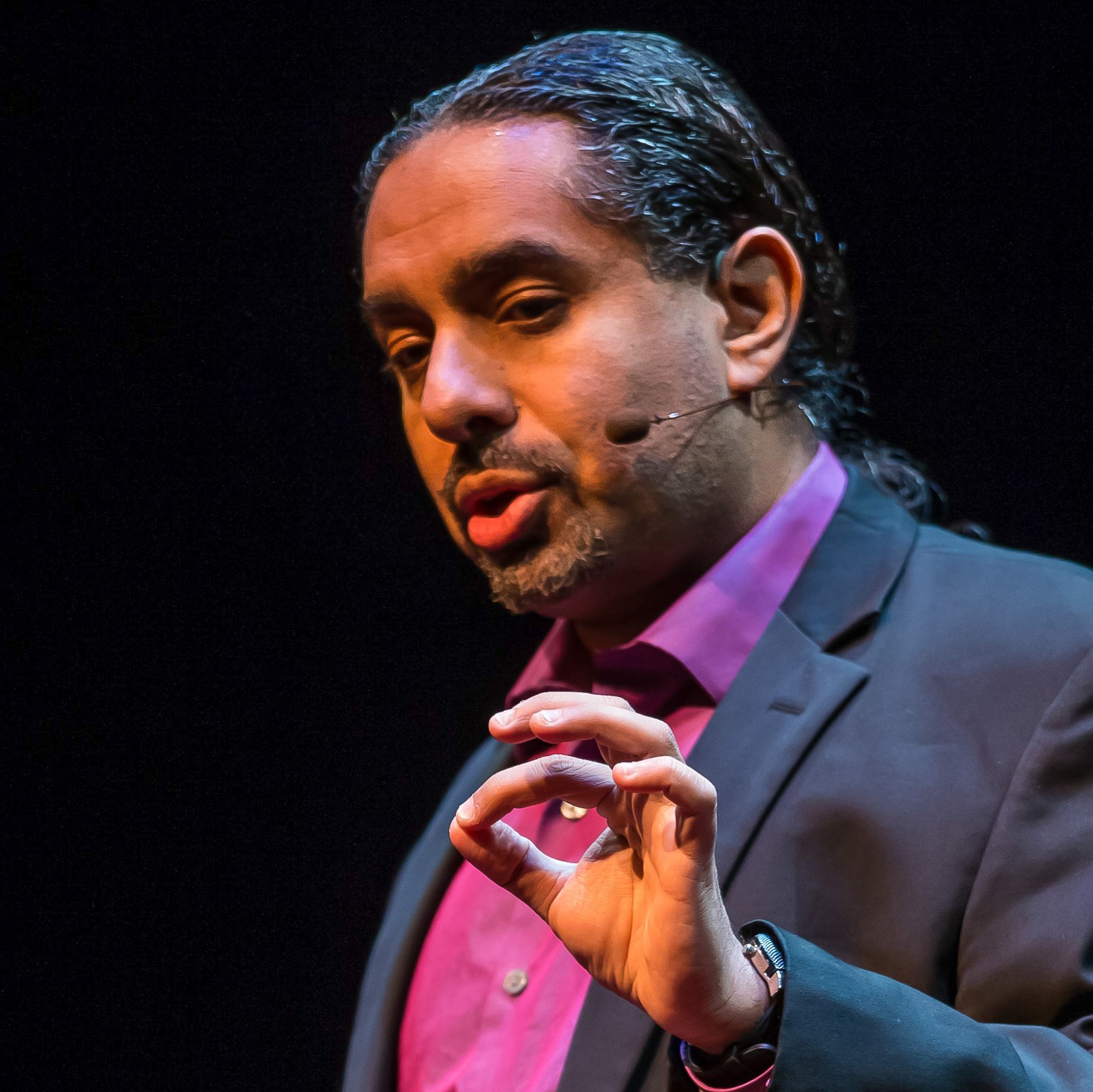
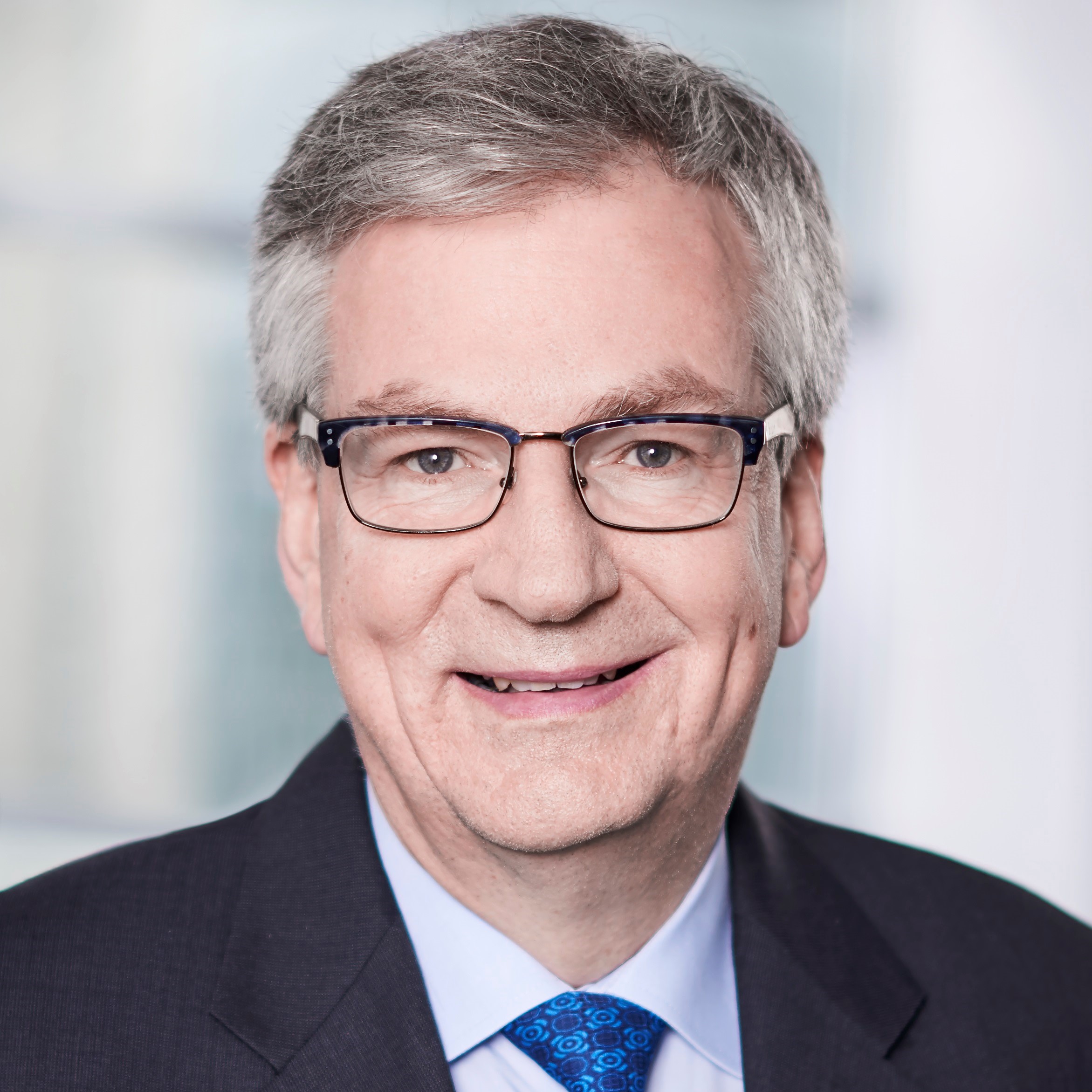
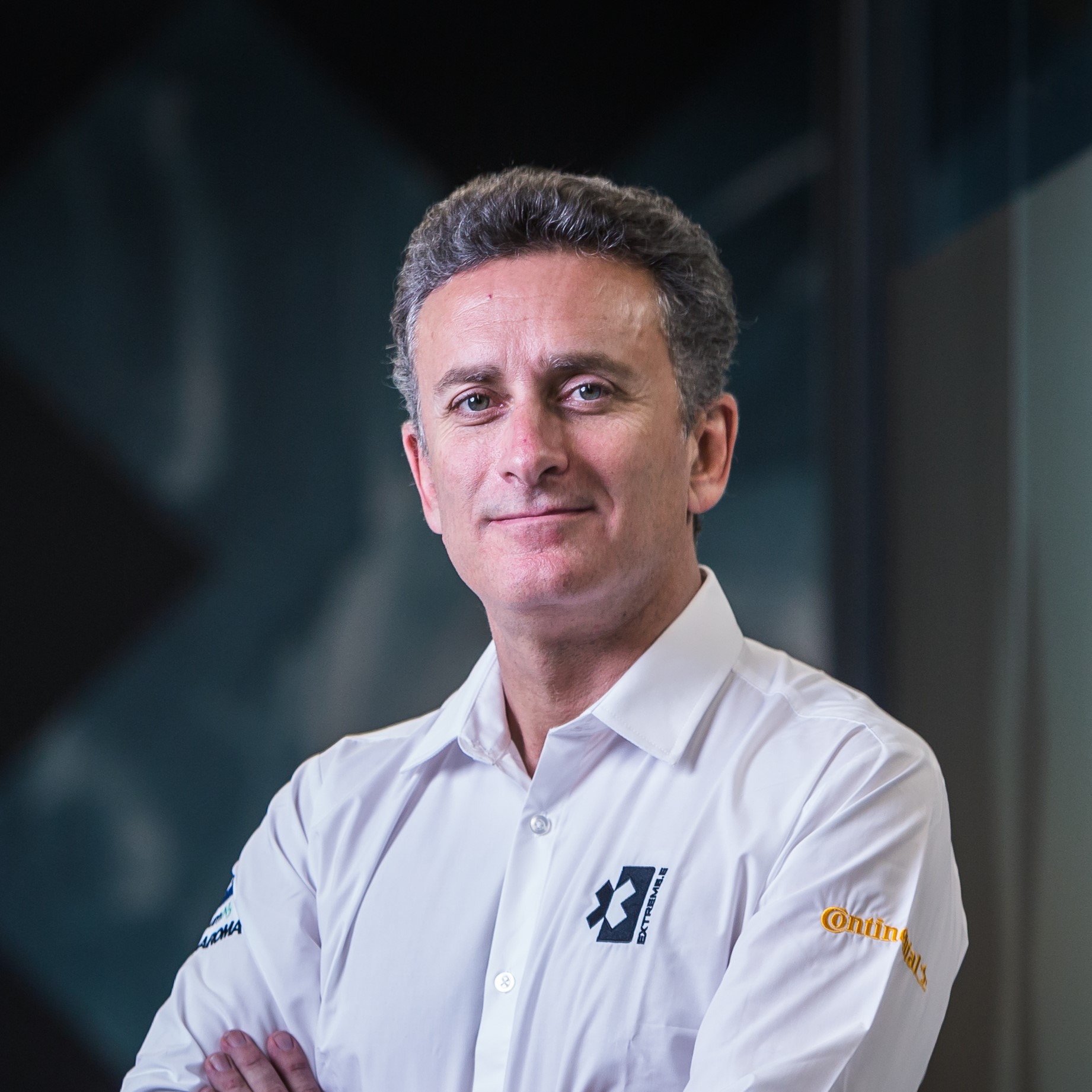
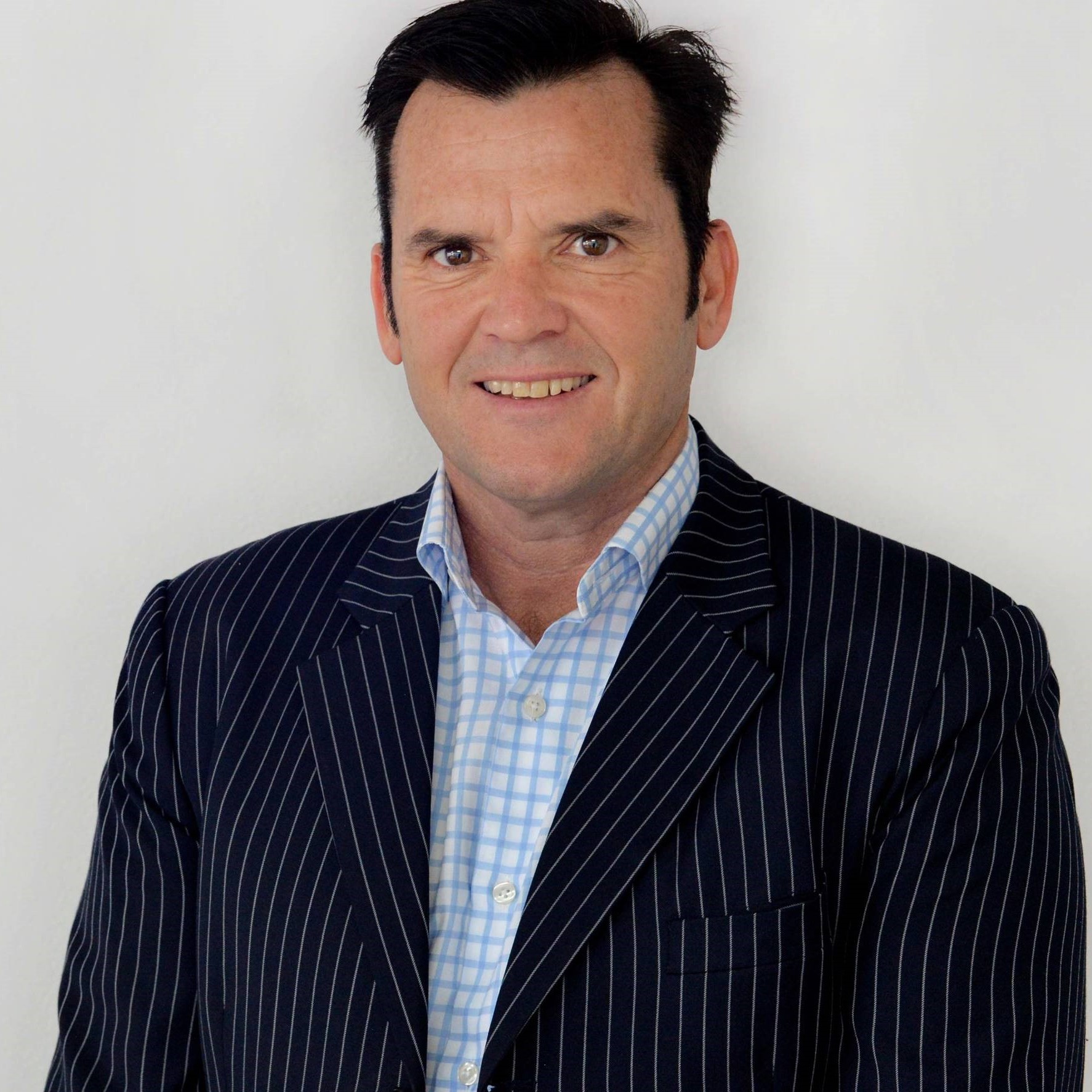
%20(3).jpg)
Sara Forni
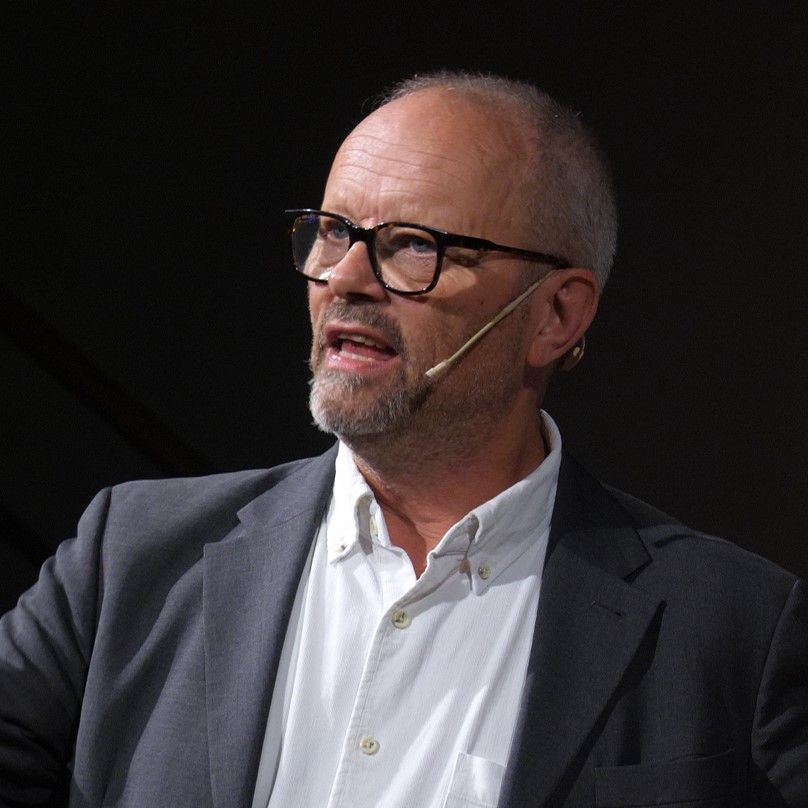
Robert Llewellyn

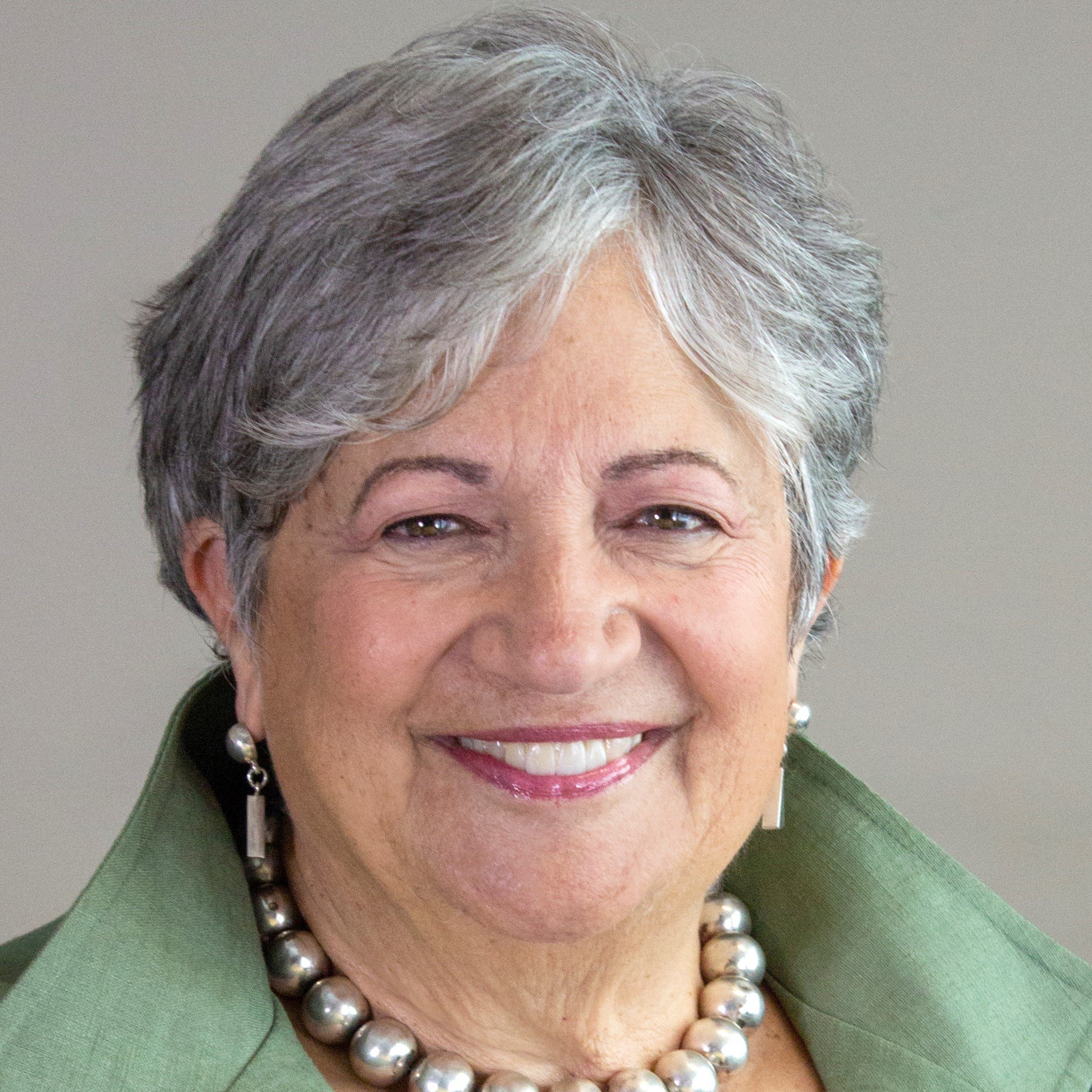

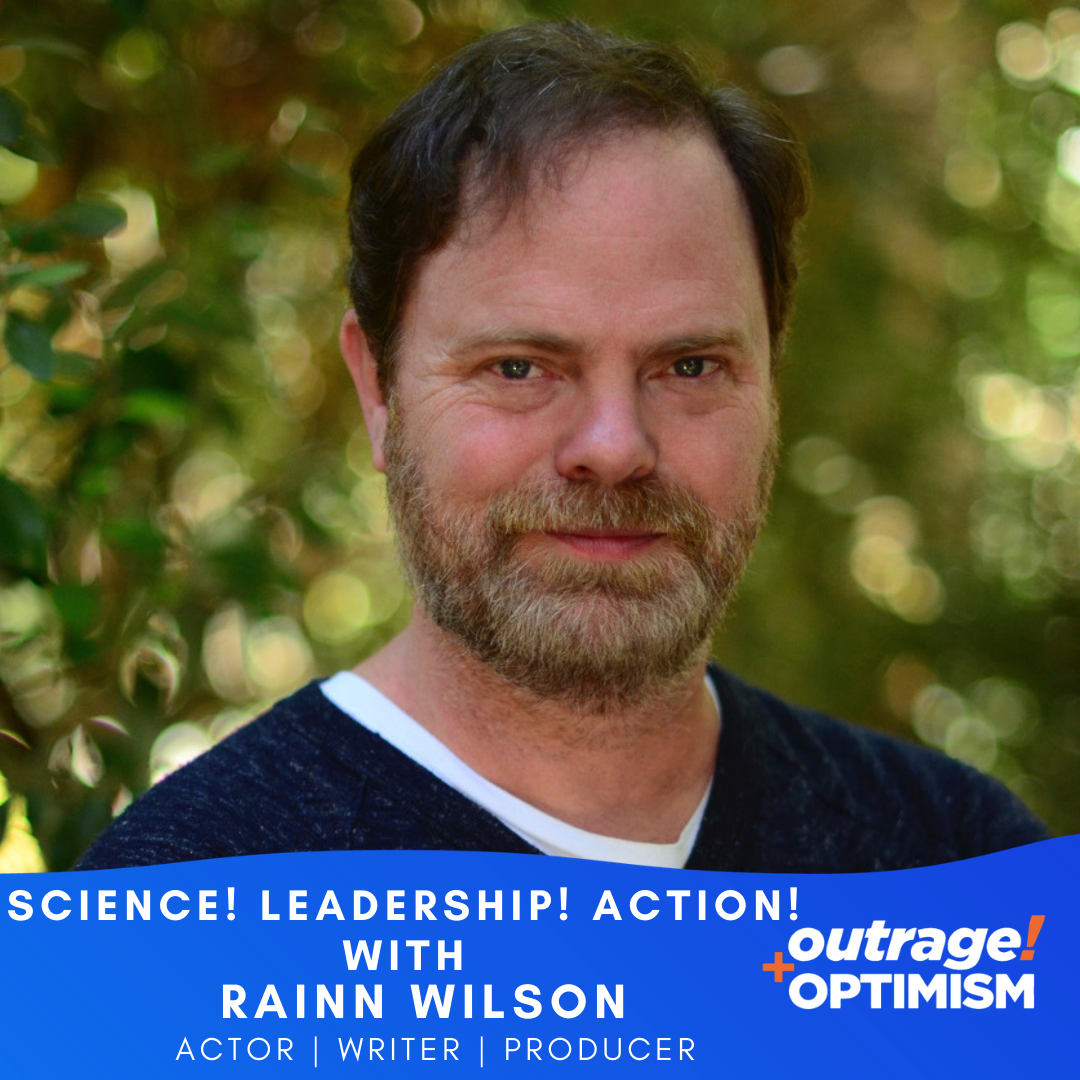
.png)
